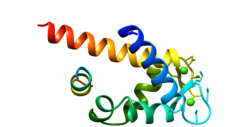| ANXA1 |
|---|
 |
| Visualisation de la protéine Cristallisée ANXA1 |
| Structures disponibles |
|---|
| PDB | Recherche d'orthologue: PDBe RCSB |
|---|
| Identifiants PDB |
|---|
1QLS, 1AIN, 1BO9 |
|
|
| Identifiants |
|---|
| Aliases | ANXA1, Annexine A1, Lipocortine 1 |
|---|
| IDs externes | OMIM: 151690 MGI: 96819 HomoloGene: 563 GeneCards: ANXA1 |
|---|
| Position du gène (Homme) |
|---|
 | | Chr. | Chromosome 9 humain[1] |
|---|
| | Locus | 9q21.13 | Début | 73,151,865 bp[1] |
|---|
| Fin | 73,170,393 bp[1] |
|---|
|
| Position du gène (Souris) |
|---|
 | | Chr. | Chromosome 19 (souris)[2] |
|---|
| | Locus | 19 B|19 13.83 cM | Début | 20,350,792 bp[2] |
|---|
| Fin | 20,368,308 bp[2] |
|---|
|
| Expression génétique |
|---|
| Bgee | | Humain | Souris (orthologue) |
|---|
| Fortement exprimé dans | - cavité buccale
- mucosa of pharynx
- gencive
- gingival epithelium
- body of tongue
- liquide amniotique
- tendon calcanéen
- palpebral conjunctiva
- epithelium of nasopharynx
- nasal epithelium
|
| | Fortement exprimé dans | - stroma of bone marrow
- granulocyte
- cordon ombilical
- corneal stroma
- epithelium of lens
- endothelial cell of lymphatic vessel
- skin of abdomen
- tibiofemoral joint
- skin of external ear
- conjunctival fornix
|
| | Plus de données d'expression de référence |
|
|---|
| BioGPS |  | | Plus de données d'expression de référence |
|
|---|
|
|
| Orthologues |
|---|
| Espèces | Homme | Souris |
|---|
| Entrez | | |
|---|
| Ensembl | | |
|---|
| UniProt | | |
|---|
| RefSeq (mRNA) | | |
|---|
| RefSeq (protéine) | | |
|---|
| Localisation (UCSC) | Chr 9: 73.15 – 73.17 Mb | Chr 19: 20.35 – 20.37 Mb |
|---|
| Publication PubMed | [3] | [4] |
|---|
|
| Wikidata |
| Voir/Editer Humain | Voir/Editer Souris |
|
L'annexine A1 (ou lipocortine 1, ou annexine 1) est une protéine de la famille des annexines, dont le gène est ANXA1 située sur le chromosome 9 humain. Elle a une activité anti-inflammatoire.
Rôles
Elle se fixe au récepteur du formyl peptide ainsi qu'à celui de l'ALX2[5], et par ce biais, intervient dans le développement de certaines métastases[6].
Elle joue également dans la cicatrisation de la muqueuse gastrique[7]. Elle est sécrétée par les cellules digestives lors d'une rectocolite hémorragique[8] ainsi que dans d'autres maladies inflammatoires intestinales[9] et pourrait agir dans la sédation du phénomène inflammatoire.
Son expression est stimulée par les corticoïdes permettant une action anti-inflammatoire[10].
Elle est fabriquée abondamment par les polynucléaires neutrophiles[11].
Au niveau cellulaire, stimulée par des ions calcium, elle se fixe aux phospholipides des membranes, contribuant à la réparation de ces dernières[12].
Notes et références
- ↑ a b et c GRCh38: Ensembl release 89: ENSG00000135046 - Ensembl, May 2017
- ↑ a b et c GRCm38: Ensembl release 89: ENSMUSG00000024659 - Ensembl, May 2017
- ↑ « Publications PubMed pour l'Homme », sur National Center for Biotechnology Information, U.S. National Library of Medicine
- ↑ « Publications PubMed pour la Souris », sur National Center for Biotechnology Information, U.S. National Library of Medicine
- ↑ Bena S, Brancaleone V, Wang JM, Perretti M, Flower RJ, Annexin A1 interaction with the FPR2/ALX receptor: identification of distinct domains and downstream associated signaling, J Biol Chem, 2012;287:24690–24697
- ↑ Babbin BA, Lee WY, Parkos CA et al. Annexin I regulates SKCO-15 cell invasion by signaling through formyl peptide receptors, J Biol Chem, 2006;281:19588–19599
- ↑ Martin GR, Perretti M, Flower RJ, Wallace JL, Annexin-1 modulates repair of gastric mucosal injury, Am J Physiol Gastrointest Liver Physiol, 2008;294:G764–G769
- ↑ Vergnolle N, Pagès P, Guimbaud R et al. Annexin 1 is secreted in situ during ulcerative colitis in humans, Inflamm Bowel Dis, 2004;10:584–592
- ↑ Leoni G, Neumann PA, Kamaly N et al. Annexin A1–containing extracellular vesicles and polymeric nanoparticles promote epithelial wound repair, J Clin Invest, 2015;125:1215–1227
- ↑ Perretti M, D’Acquisto F, Annexin A1 and glucocorticoids as effectors of the resolution of inflammation, Nat Rev Immunol, 2009;9:62–70
- ↑ Dalli J, Norling LV, Renshaw D, Cooper D, Leung KY, Perretti M, Annexin 1 mediates the rapid anti-inflammatory effects of neutrophil-derived microparticles, Blood, 2008;112:2512–2519
- ↑ McNeil AK, Rescher U, Gerke V, McNeil PL, Requirement for annexin A1 in plasma membrane repair, J Biol Chem, 2006;281:35202–35207
 Portail de la médecine
Portail de la médecine  Portail de la biologie cellulaire et moléculaire
Portail de la biologie cellulaire et moléculaire
'

 Portail de la médecine
Portail de la médecine  Portail de la biologie cellulaire et moléculaire
Portail de la biologie cellulaire et moléculaire 


















